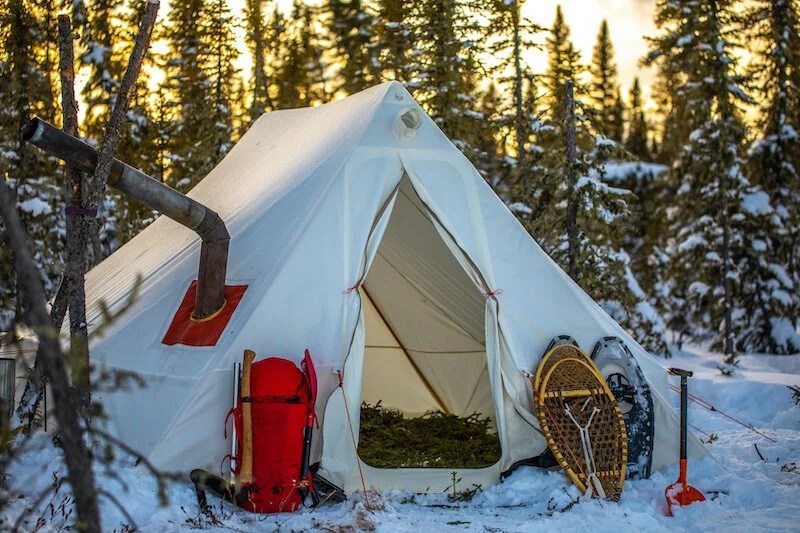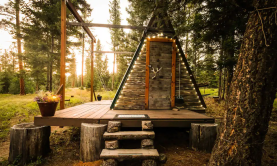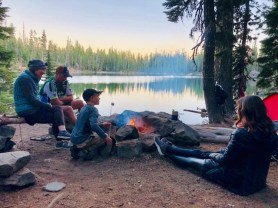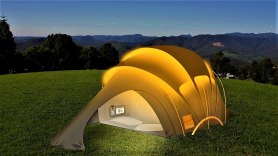

One of the lesser used but best ways to camp in the winter is hot tent winter camping. It makes for one of the comfiest and easiest settings in the otherwise brutal environment of the winter wilderness.
Videos by Outdoors with Bear Grylls
However, not everyone can do hot tent camping in the winter and there are a few drawbacks to them. There’s a reason not everyone brings a hot tent to their winter campsites: despite how useful they are, they can be a hassle.
Let’s start with some basics.
What Are Hot Tents?

Hot tents are much more complex than your standard pole tent and are defined by some of these features:
- Wood burning stove
- Canvas material
- Opening for an exhaust pipe
- Removable floor
The most noticeable feature of a hot tent is its wood-burning stove. This is where the heat will come from and keep your tent pleasantly toasty even in the coldest winter weather.
Of course, hot tents will need an exhaust pipe for this stove because of all the smoke it produces. You will need a port in the roof or wall to attach an exhaust pipe to the wood stove. Without this pipe, your tent would fill up with smoke from the stove in minutes and be completely unusable.
Also, these tents are usually made from a different kind of material than a typical tent. This material is canvas and is designed to withstand tough winter conditions while keeping in heat. Cheaper hot tents will be made of other material that can stll keep in heat. However, they will be more prone to tearing in harsher conditions.
Another peculiar feature of a hot tent is its removable floor. During the winter months you can detach this floor so it doesn’t freeze to the ground.
The Benefits Of Hot Tents
Many campers who are looking for the most comfortable experience in winter camping opt for this.
To start, it is great for family excursions to the outdoors. Camping in the winter is very difficult with children because they are much more susceptible to the cold.
With hot tents, there is always a warm home base to come back to. If you are planning a hike on a cold winter day, that is a nice reward.
Plus, there is a certain aesthetic to wood stoves that can’t be had in regular space heaters. The smell of wood burning really gives you that sense of being out in the wilderness. It is also great to fall asleep to.
Another benefit to hot tents is that they are generally much more spacious than most standard camping tents. These tents need the extra space to fit the wood stove and multiple people, so there is usually a fair amount of space to bring extra food or books without having to cram them in.
What’s more, you don’t even have to bring a propane or gas stove because the wood stove is perfect for cooking! Whether it’s roasting marshmallows or boiling water for oatmeal, the wood stove is just as good for cooking as any bonfire.
The Disadvantages Of Hot Tents
While hot tents are a wonderful way to camp in the winter they are a heavy load to carry out to the campsite. Plus, building them usually requires the help of an extra person or two, so you will have to plan out using a hot tent well in advance to the camping trip itself.
Also, hot tents are much more expensive than regular camping tents. Usually, the wood stoves for these tents are sold separately as well, so getting a hot tent is only a good idea if you really plan to go winter camping a lot.
Hot Tent Safety Tips
Hot tents themselves are typically very safe so long as they are set up right. Keeping that in mind, make sure that the tent is set up how the instructions tell you so cold air doesn’t seep in.
Truth being told, the wood stove is definitely the most dangerous part of a hot tent and it is very important that you set this up correctly. The fire in the stove should always be contained and the exhaust pipe needs to be set up properly so you don’t get smoked out of your tent when running the stove.









